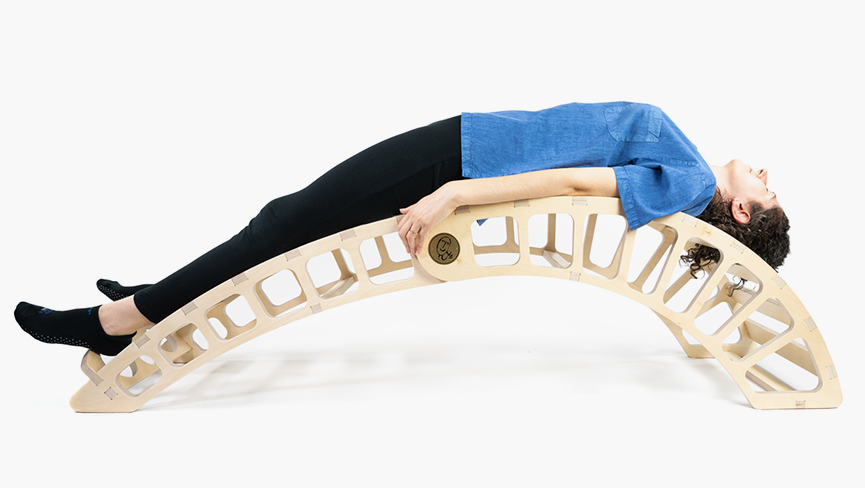Bridge to Flexibility and Body Alignment
Posted by Michela Mangiarancina on Apr 28th 2023
Do you find yourself feeling stiff and out of alignment? Maybe you struggle with sitting up straight or moving easily. Perhaps you experience cold extremities or a constant state of irritability. If so, you're not alone. Many of us experience these symptoms as a result of modern lifestyles that involve prolonged sitting, repetitive tasks, and other factors that take a toll on our bodies.
The parts of your body most affected by these habits are our spine, hips, back, shoulders, and neck. Your back and spine especially hold you up, and the spine influences all the important functions of your body through the central channel of your nervous system. When you are stressed, afraid, or lack core strength, your back and spine tend to curve inward protectively. However, this can cause your spine to become tight or contracted, hindering proper energy flow throughout the body, leading to more stiffness, and potentially pain and other physical and mental issues.
Mindful stretching can help counteract the effects of modern life and improve your overall well-being. In particular, backbend stretches help reverse the effects of poor posture and curving your back inward. Backbends involve rounding the front of your body and creating an extended curve in your spine, which can help balance and remove the tension from your spine and back, increasing your flexibility and range of motion. At the same time, they stretch your abdomen and open your chest, improving energy flow through the front of your body, aiding digestion and breathing, opening your heart and releasing emotional energy.
Not everyone is in the best condition to do backbends, and if they are not done properly, they can lead to further tension, misalignment, and injury. One solution is using a backbending bench such as the Rainbow Bridge.
What Is the Rainbow Bridge?
The Rainbow Bridge is a body-length wooden bench that’s ergonomically curved to stretch your entire spine. It naturally positions your body safely against gravity in a way that’s just enough to give your vertebrae room to stretch and breathe, while supporting your shoulders, neck, and head and preventing too much blood from rushing to your head. Simply laying on it and doing deep breathing can elongate your spine and balance the right and left sides of your body.
The horizontal rungs allow you to take different positions on the bench to stretch your body at various angles to suit your body's needs. Want a little more stretching? Step up on a higher rung and lie down to let gravity push against you deeper. Too much stimulation and want to lighten it up? Step down on a lower rung to ease the pressure. The positions and postures are completely customizable to you to cater your level of tension and fitness.
The Rainbow Bridge is made of sturdy, lightweight wood. It folds in half and has handles that make it easy to be carried and stored.

Benefits of the Rainbow Bridge
The main benefit of using the Rainbow Bridge is to ease neck, shoulder, chest, back, and hip tension. However, the slight pressure from gravity also adds an energetic benefit. The gentle curve going down from the chest to the head sends more blood flow and more oxygen to the brain, combating fatigue and giving you more energy without the headrush.
Stretching your vertebrae allows for more relaxed breathing and better blood, lymph, and energy circulation to rejuvenate your body.
When using the Rainbow Bridge you can feel:
- Spinal extension and alignment
- Stress relief
- A calm and clear mind
- More energy and vitality
- Greater mobility
How to Use the Rainbow Bridge

Position for chest and back stretching

Position for neck, shoulders, back stretching

Position for hip, leg stretching
1: Slowly ease your way down onto the Rainbow Bridge. You can use your hands to control your movement. Breathe comfortably and bring your attention to your body's sensations. Scan your body from head to toe. Feel each part and take note of any pain, tension, or stiffness you’re holding.
2: Once you’re more aware of how your body feels, adjust your body along the bench so that more painful or tense areas are stimulated the most. As you do this, try extending your arms or shaking your head side to side to stimulate your body in different ways. You can also hold the sides of the bench for better support.
3: For each posture on the Rainbow Bridge, take a few minutes to relax and breathe naturally as you hold it. Open your mouth slightly as you exhale, letting your breath come out without force. Keep feeling your body, especially the most painful spots, as tension and pain gradually reduce and your mind becomes calmer.
4: Hold the rungs with your hands for support and gently roll onto your side and sit up when you’re finished. Stay seated and ground your body for one minute before standing up carefully.
There’s no need to stay on the Rainbow Bridge for a long time—even five minutes can be effective. When you incorporate this tool into your everyday routine, you can feel lighter, freer, and more balanced physically, mentally, and emotionally.
Interested in trying the Rainbow Bridge? Check it out here and let us know what you think!


